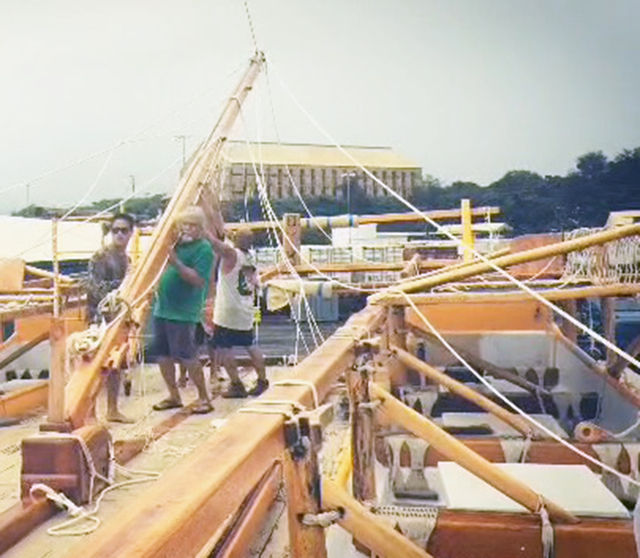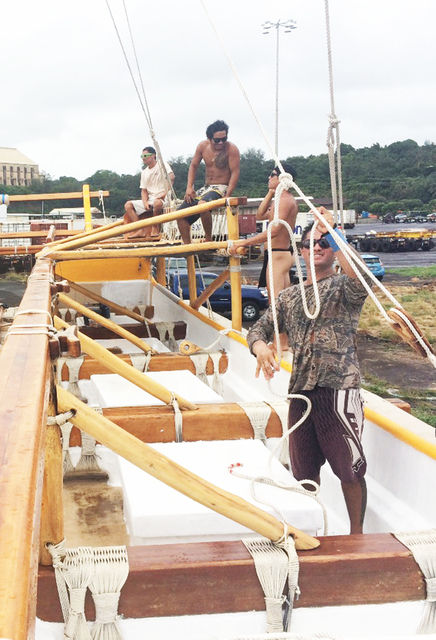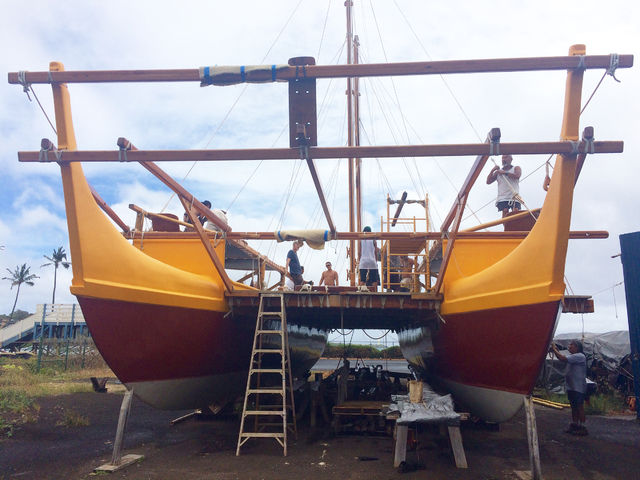Seventeen years ago, a trio of experienced voyagers from Kauai set in motion a dream to build the island’s first long-distance Polynesian sailing canoe in more than a century. Drawing on knowledge and experience gleaned aboard Hawaii’s famous Hokulea, John
Seventeen years ago, a trio of experienced voyagers from Kauai set in motion a dream to build the island’s first long-distance Polynesian sailing canoe in more than a century.
Drawing on knowledge and experience gleaned aboard Hawaii’s famous Hokulea, John Kruse, Dennis Chun and Pat Aiu began creating what would one day become one of the largest voyaging canoes in all of Polynesia.
“We had grand ideas that we’d get 50 volunteers every weekend and we’d build this thing in one year,” said Chun, a Hawaiian studies instructor at Kauai Community College. “It never happened. We really didn’t know what we were getting into.”
For starters, the men didn’t known how to build a hull from scratch. They didn’t have a work space. And they didn’t have money to buy supplies.
But, over time, the grant money came in, a work space materialized and engineers were generous with their time.
Now, nearly two decades in, Namahoe is almost ready for its inaugural sail. Chun estimates the canoe is about 80 percent complete.
When that day comes, the first order of business will be a round-the-island voyage. Then, Chun said, there will be inter-island trips during which the crew will “show off” Kauai’s canoe. Ultimately, the plan for Namahoe is to sail her to Tahiti to coincide with the arrival of Hokulea, marking the end of a three-year voyage around the globe.
“Namahoe” translates to “the twins,” representing the canoe’s twin hulls. It’s also the Hawaiian term for the constellation Gemini, which serves as one of the navigation points between Oahu and Kauai.
Measuring more than 70 feet, Namahoe is longer than the other islands’ canoes. When finished, it will easily be able to accommodate classes of 20 or 30 schoolchildren on day sails. Its length is also a safety feature.
The canoe will create opportunities for Kauai’s youth to experience a first-hand connection with the people who sailed to and settled the Hawaiian islands. Each of the other counties in the state already has its own sailing vessel.
“You put your soul in the canoe,” said Kaimi Hermosura, who has been helping with the project for years. “Everything we made from scratch.”
Chun, a longtime Hokulea crew member, said he and the other volunteers who’ve dedicated countless hours to build a canoe for Kauai aren’t looking to eliminate Hokulea’s place. Rather, they’re adding to her family.
Namahoe, he said, is the baby of Hokulea, the Polynesian Voyaging Society’s legendary sailing canoe that first sailed to Tahiti in 1976 and always attracts community attention on its visits here.
“You always have skeptics,” Chun said. “People say, ‘Why? We already have Hokulea.’ But where is Hokulea? It’s not here. How often is Hokulea on Kauai? Not very often. How can you develop continuous curriculum and activities with an entity that comes over here every five years?
“I tell the students, ‘You’re going to understand wayfinding, you’re going to understand sailing, you’re going to understand how to do this — but you’re not going to be able to do it because you’re not out there on a canoe that’s moving on the water in the elements.”
Namahoe, Chun hopes, can change that by bridging the gap between theory and practicality.
“I used to think it was important to just perpetuate the knowledge and the tradition,” Chun said. “But I think what comes out of this is being able to understand your relationship to the environment and how the ancients knew that and adapted their lifestyle to include the environment as part of them, rather than putting themselves above the environment.”
Chun envisions Namahoe as a way to connect modern students and subject matter with ancient times and teachings. When students’ only methods of navigation are to rely upon the stars, the sun, the moon and other natural elements, subjects like science and mathematics will become more purposeful.
When out to sea for days on a boat with finite amounts of food and water, resource management will become real and no longer an abstract concept, he added.
“When you say, ‘We have to take care of the land, we’ve got to malama each other,’ those are just words,” Chun said. “But when you’re on the canoe in the ocean, all of those things are right in your face.”




